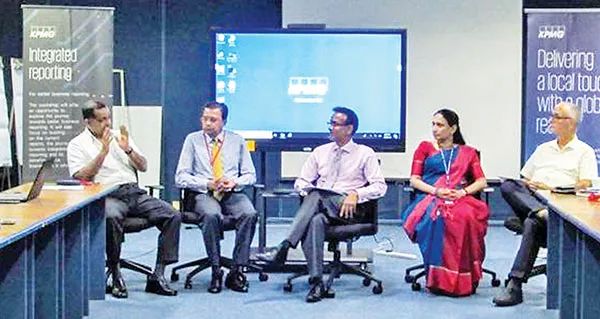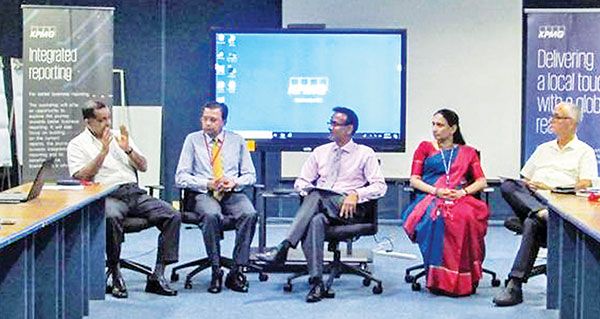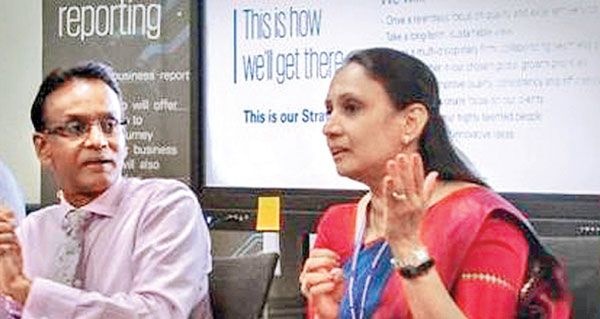KPMG Sri Lanka Hosts 19th Audit Committee Forum on Key Audit Matters
The 19th edition of the Audit Committee Forum hosted by KPMG focused on discussing the impact of Key Audit Matters (KAMs) reported in the auditor’s report. This was considered groundbreaking as for the first time, there is transparency in the most important audit issues that were discussed between the audit engagement partner and the audit committee, which are reflected on the audit report.
The Forum was organized to discuss “Key Audit Matters and the role Board Audit Committees can play.”Because, now investors would receive more contextual information about the audit that would help them differentiate better between companies that had received ‘clean’ audit reports. Therefore, audit committees felt they have to play a key role in the disclosures made under KAMs by auditors.


The panelists (left to right): D. Soosaipillai (Non-Executive Director HNB and Commercial Credit), Sanath Fernando (Partner – Ernst & Young), Suren Rajakarier (Partner - KPMG), Ranjani Joseph (Partner KPMG) andMr. Richard Ebell (Non-Executive Director – Cargills Bank)
Improved Governance
Under the sub topic of “How KAMs contribute to improved governance?,” Rajakarier presenting views of Lalit Wijeyeratne (Non Ex Director) noted that overall KAMs are valuable to shareholders , investors and other stakeholders to get a better understanding of the company’s business environment and its risk profile. It also improved dialogue between BODs, BACs (Board Audit Committee) and the Auditor. KAMs also leads to better Board focus on Governance issues i.e ,effectiveness of internal controls ,introduction of performance measures, effectiveness of oversight committees. At the same time Auditors are exposed to report in the manner in which the KAMs have been dealt with that is Leading to improvement in –Audit quality.


What is a KAM
Fernando sharing his view on why a risk would be identified as a KAM stated that KAMs are highlighted based on the Auditor’s professional judgement and the factors that the auditor takes into consideration are the significance of events during the year, risk associated, size of accounting balance and matters where significant auditor judgement was required on estimates/other transactions. He highlighted that in determining KAMs, auditors adopt a 3-tiered filtration process comprising (1) Matters communicated to those charged with governance (2) Matters that require significant auditor attention (3) Key audit maters. It was noted that key audit matters are selected from matters communicated with those charged with governance.
Managing KAMs
Soosaipillai then shared his views on how the BAC can manage the process for KAMs. He stated that a proactive approach needs to be used in the process and should begin as early as possible. The BAC should carefully examine the audit plan including possible reporting risks which could be the first flags of possible KAMs. Further, the BAC should request for an interim issues memorandum from the auditors before the year end to have a better understanding of KAMs.
Responsibility of BAC
Ebell discussed; “Responsibility of the BAC in accepting assumptions/judgements made by management,external consultants and valuers.”
He stated BACs should identify significant judgements,assumptions made including the effective useful lives of PPE, property valuations, fair value valuations and loan impairment provisioning and advise the Board accordingly.
With regards to valuations, the qualifications and credentials of the valuers should be considered, in addition to close auditor participation and management interaction. He also noted, key challenges such as future cash-flow based valuations, deferred tax provisions, assessment of intangibles and impairment provisioning which may require some expert guidance.
He was of the view, the BACs should question and challenge both internal and expert assumptions.
Common KAMs
Ranjani Joseph presented the types of KAMs that were presented globally and locally. KPMG had reviewed 128 audit reports of listed companies and identified the top 5 KAMs as Goodwill, revenue, inventory, taxation and acquisitions. She pointed out that the main reason behind these common KAMS would be due to fair value estimations, significant audit effort and risk. Revenue is generally considered as a key measure of performance and is impacted by SLFRS15, thus being a common KAM among entities. Inventory is also considered as a KAM due to the macro trend of uncertainty in consumer preferences leading to obsolescence of inventory held.
The panel discussion moderated by Suren Rajakarier, was interactive and agreed that reporting of KAMs has contributed to a general improvement of governance. There is, so far, no evidence of KAMs being used defensively to reduce the auditor’s liability but it has improved audit quality too. The Forum believes, it’s reasonable to expect the users’ assessment of an entity’s economic situation to be more negative if the auditor’s report includes a KAM section with a rather negative tendency as compared to a KAM section with a rather positive tendency. Therefore, the BAC should take early note of such instances and judiciously reduce any negative effects. Also, fair value determination based on future cash flows or market value based on SLFRS 13 basis is complex and susceptible to manipulation.
The BAC advises the Board on the integrity of financial statements and therefore, it must identify significant judgments / assumptions made, and seek to validate them.
The Forum which operates under the aegis of the Sri Lanka Institute of Directors has been supported and enabled since inception by KPMG, in line with its globally recognized Audit Committee Institute initiative. Suren Rajakarier facilitates these sessions using appropriate KPMG thought leadership during the sessions and moderates the discussions. These discussions have contributed to improving governance and better audit committee practices by its members, thereby increasing confidence in the capital market.